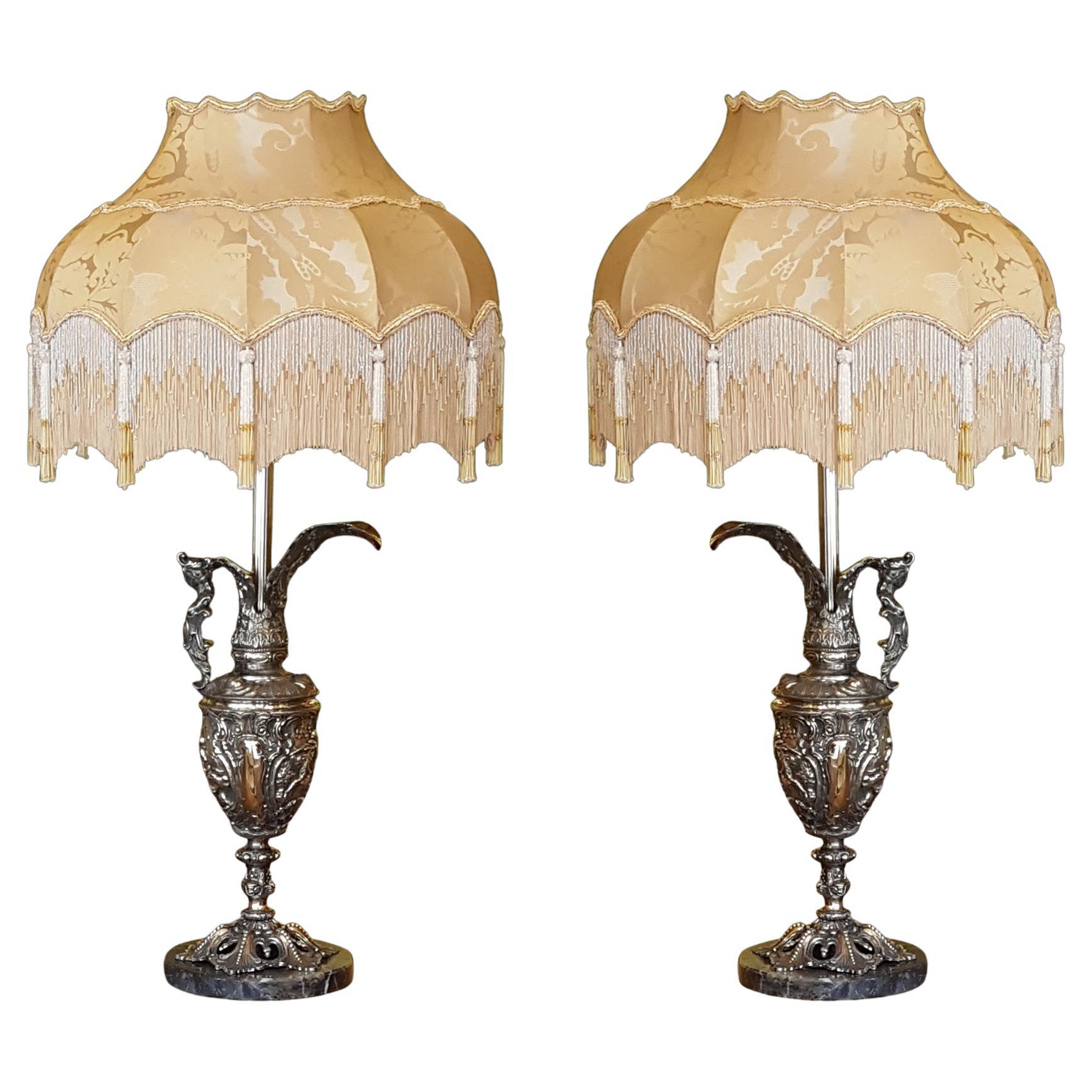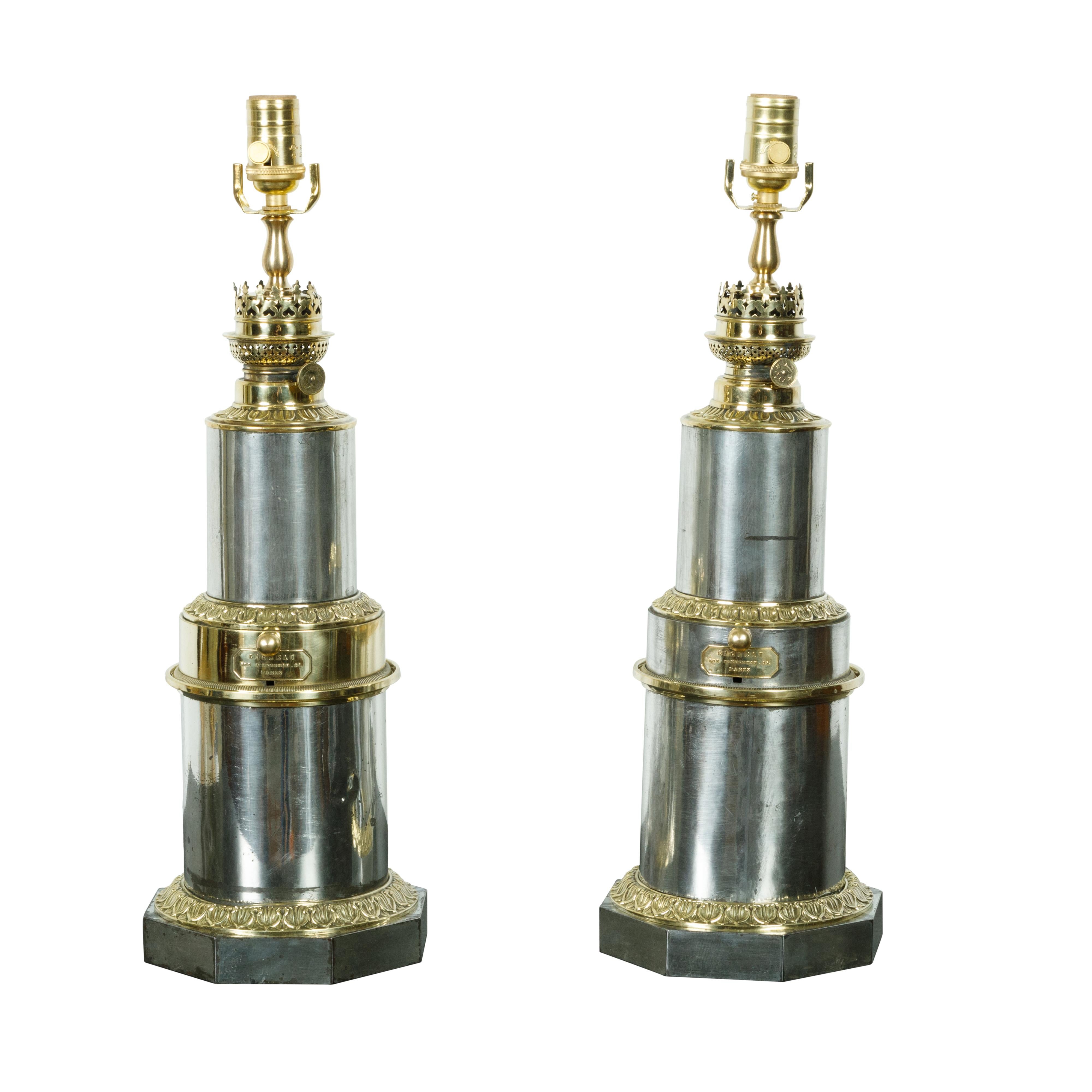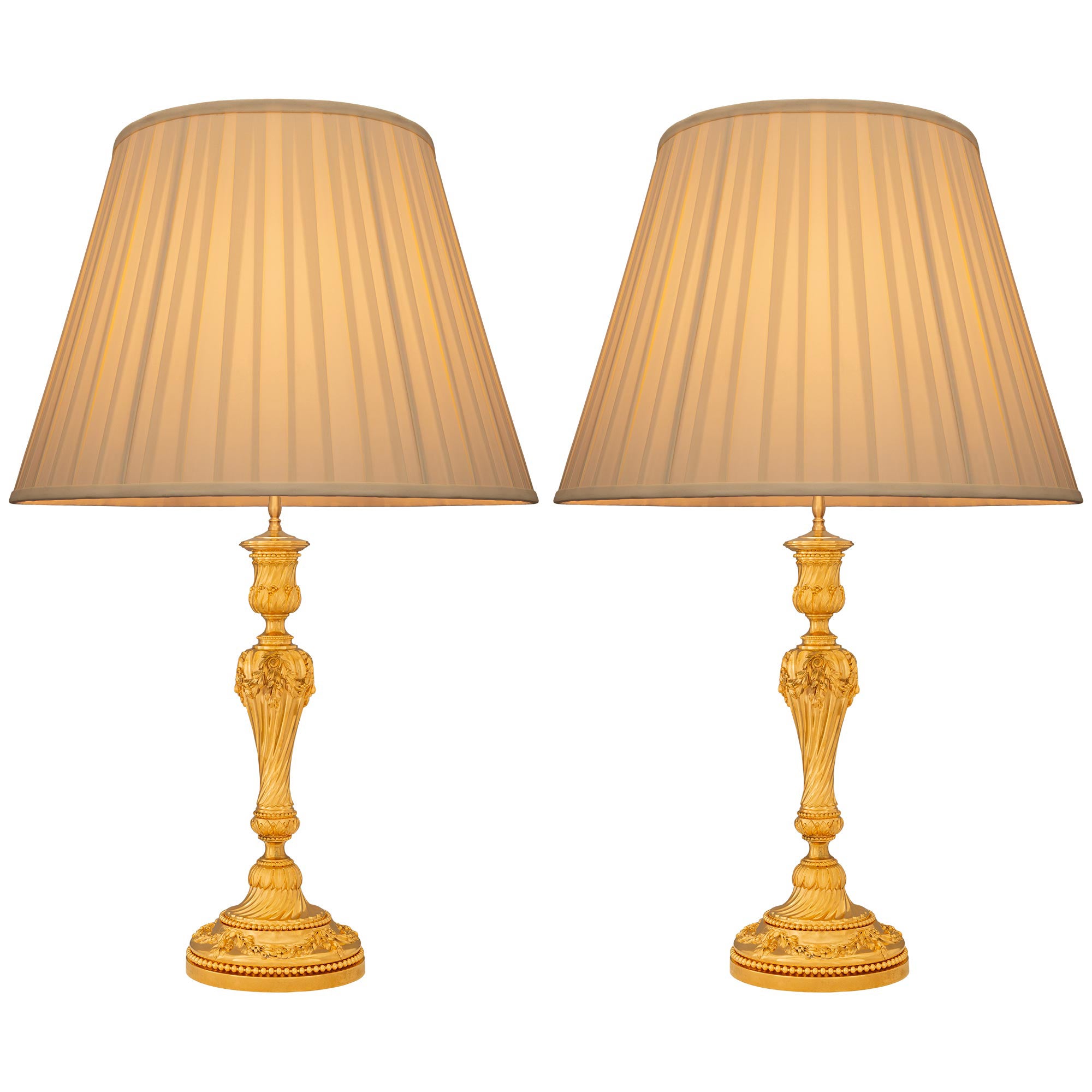Items Similar to Maison Gagneau, Pair of Lamp in Guilloche Gilt Brass, Late 19th Century
Want more images or videos?
Request additional images or videos from the seller
1 of 7
Maison Gagneau, Pair of Lamp in Guilloche Gilt Brass, Late 19th Century
About the Item
Maison Gagneau, signed.
Pair of baluster shape lamps in guilloche gilt brass. They stand on a circular base. The collar is circled with a silvered ring.
Stamped “Gagneau, 115 R. Lafayette” on the openwork beak.
Work realized in the late 19th century.
New and functional electrical system.
! The price doesn’t include the lampshade price. However, our workshop can advise you with pleasure and realize it with your size and color choices !
Maison Gagneau, created in 1800 in Paris, is a bronzer and a lightings producer very popular during the 19th century. First established in the 25, rue d’Enghien, Maison Gagneau settled at the 115 rue Lafayette. She participates at the famous French and Internation exhibitions : les Expositions des Produits de l’Industrie and also Expositions Universelles and won several distinctions ; she was even also a member of the jury during the 1889 Exposition Universelle.
- Creator:Gagneau Paris (Author)
- Dimensions:Height: 25.6 in (65 cm)Diameter: 5.91 in (15 cm)
- Sold As:Set of 2
- Materials and Techniques:
- Place of Origin:
- Period:
- Date of Manufacture:1880
- Condition:Rewired. Wear consistent with age and use.
- Seller Location:Saint-Ouen, FR
- Reference Number:
About the Seller
5.0
Vetted Seller
These experienced sellers undergo a comprehensive evaluation by our team of in-house experts.
Established in 1990
1stDibs seller since 2012
238 sales on 1stDibs
Typical response time: 1 hour
- ShippingRetrieving quote...Ships From: Saint-Ouen, France
- Return PolicyThis item cannot be returned.
More From This SellerView All
- Pair of Arabian Style Lamps in Gilt Brass and Bronze, 19th CenturyLocated in Saint-Ouen, FRPair of Arabian style lamps in chiselled and gilt brass bronze with a baluster shape standing on a circular quadripod scalloped base with motifs of scrolls on a guilloche background....Category
Antique Late 19th Century European Table Lamps
MaterialsBrass, Bronze
- Maison Gagneau, Pair of Louis XVI Style Lamps, circa 1880By Gagneau FrèresLocated in Saint-Ouen, FRMaison Gagneau, signed. Pair of baluster shape Louis XVI style lamps in guilloche brown brass. Chiselled and gilt bronze mount. High of the mount with...Category
Antique 1880s European Napoleon III Table Lamps
MaterialsBrass
- Pair of Lamps in Canton Porcelain and Gilt Bronze, 19th CenturyLocated in Saint-Ouen, FRPair of baluster shape lamps in Canton porcelain and gilt bronze. Decor of pattern flowers surrounding a medallion which represents a genre scene. Chiseled and gilt bronze mount. Ape...Category
Antique 19th Century Asian Chinese Export Table Lamps
MaterialsBronze
- Pair of Porcelain Lamps with Imari Decor, Late 19th CenturyLocated in Saint-Ouen, FRPair of baluster shaped lamps in Imari porcelain. Chiselled and gilt bronze mount, standing on a moulded square shape base. Lamp body bottom part decorated with a frieze of blue edgi...Category
Antique Late 19th Century French Chinoiserie Table Lamps
MaterialsBronze
- Pair of Lamps in Gien Porcelain, 19th CenturyLocated in Saint-Ouen, FRPair of calabash-shaped lamps in Gien porcelain. Body adorned with floral motifs and figurative decor on a white background in which we can see human figures and objects. Mount and b...Category
Antique 19th Century European Other Table Lamps
MaterialsPorcelain
- Pair Of Silvered Brass and Bronze Lamps, 19th centuryLocated in Saint-Ouen, FRPair of gilt brass and bronze bottle-shaped lamps, standing on an arabesque engraved base. A bamboo frieze underline the belly and the neck. Work from the second half of the 19th ce...Category
Antique 19th Century French Rococo Table Lamps
MaterialsMetal
You May Also Like
- Pair of Late 19th Century Gilt Ewer LampsLocated in Altrincham, GBPair of Late 19th century gilt metal ewers of large design having bacchanalian relief decoration on marble bases, converted to electric lamps 22"diam x adju...Category
Antique Late 19th Century European Neoclassical Revival Table Lamps
MaterialsMarble, Bronze
- Pair of Porcelain Vases Ormolu-Mounted in Lamps by Gagneau Paris XIXth CenturyBy Gagneau ParisLocated in Saint-Ouen, FRPair of large Japanese Porcelain Cone Shape Vases with Imari decoration Important mounts in ormolu and gilded metal, the base decorated with a laurel wreath, the upper part of falling leaves and a frieze of knotted ribbon. The mounts signed Gagneau, 115 R. Lafayette. Circa 1860 With their original aluminium bulb cover and original gilding Vase it self Height 47 cm The Gagneau Company is one of the most famous lighting factories in Paris in the nine-teenth century, established in 1800 at 25 rue d'Enghien in Paris and later at 115 rue de Lafayette. She has participated in many exhibitions throughout this century. She began in 1819 with the Exposition des Produits de l'Industrie and later participated in the Universal Exhibitions where she was part of the jury in the category of art bronzes (class 25) at the Universal Exhibition in Paris in 1889. "Imari" was simply the trans-shipment port for Arita wares, from where they went to the for-eign trading outposts at Nagasaki. It was the kilns at Arita which formed the heart of the Japanese porcelain industry. Arita's kilns were set up in the 17th century, after kaolin was discovered in 1616. A popular legend attributes the discovery to an immigrant Korean potter, Yi Sam-Pyeong (1579–1655), although most historians consider this doubtful. After the discovery, some kilns began to produce revised Korean-style blue and white porcelains, known as Early Imari, or "Shoki-Imari". In the mid-17th century, there were also many Chinese refugees in northern Kyushu due to the turmoil in China, and it is said that one of them brought the overglaze enamel coloring technique to Arita. Thus Shoki-Imari developed into Ko-Kutani, Imari, and later Kakiemon, which are sometimes taken as a wider group of Imari wares. Ko-Kutani was produced around 1650 for both export and domestic market.Kutani Ware is characterized by vivid green, blue, purple, yellow and red colors in bold designs of landscapes and nature. Blue and white porcelain pieces continued to be produced and they are called Ai-Kutani. Ko-Kutani Imari for the export market usually adopted Chinese design structure such as kraak style, whereas Ai-Kutani for the domestic market were highly unique in design and are ac-cordingly valued very much among collectors. Ko-Kutani style evolved into Kakiemon-style Imari, which was produced for about 50 years around 1700. Kakiemon was characterized by crisp lines, and bright blue, red and green designs of dramatically stylized floral and bird scenes. Imari achieved its technical and aes-thetic peak in the Kakiemon style, and it dominated the European market. Blue and white Kakiemon is called Ai-Kakiemon. The Kakiemon style transformed into Kinrande in the 18th century, using underglaze blue and overglaze red and gold enamels, and later additional colors. Imari began to be exported to Europe when the Chinese kilns at Jingdezhen were damaged in the political chaos and the new Qing dynasty government halted trade in 1656–1684. Ex-ports to Europe were made through the Dutch East India Company, and in Europe the des-ignation "Imari porcelain" connotes Arita wares of mostly Kinrande Imari. Export of Imari to Europe stopped in mid-18th century when China resumed export to Eu-rope, since Imari was not able to compete against Chinese products due to high labor costs. By that time, however, both Imari and Kakiemon styles were already so popular among Eu-ropeans that the Chinese export porcelain copied both, a type known as Chinese Imari. At the same time, European kilns, such as Meissen and English potteries such as Johnson Bros. and (Royal) Crown Derby, also imitated the Imari and Kakiemon styles. Export of Imari surged again in late 19th century (Meiji era) when Japonism flourished in Europe.Thus, in the western world today, two kinds of true Japanese Imari can...Category
Antique 1880s French Japonisme Table Lamps
MaterialsBronze
- Pair of French 1920s Gagneau Paris Steel and Brass Table Lamps with WaterleavesBy Gagneau ParisLocated in Atlanta, GAA pair of French Gagneau Paris steel and brass table lamps from the early 20th century with waterleaf motifs. Created in France during the first quarter of the 20th century, each of ...Category
Early 20th Century French Table Lamps
MaterialsBrass, Steel
- Beautiful Pair of Late 19th Century Gilt Bronze Mounted Granite LampsLocated in New York, NYA Beautiful pair of late 19th century gilt bronze-mounted granite lamps Casted bronze satire masks on either side with berries and oak leaves running a...Category
Antique Late 19th Century French Belle Époque Table Lamps
MaterialsGranite, Bronze
- Pair Of French 19th Century Louis XVI St. Ormolu Lamps, Signed Gagneau ParisLocated in West Palm Beach, FLA stunning and wonderfully detailed pair of French 19th century Louis XVI st. Ormolu lamps, signed Gagneau Paris. Each lamp is raised by a circular pedestal with a beaded edge. Above...Category
Antique 19th Century French Louis XVI Table Lamps
MaterialsOrmolu
- Pair of Late 19th Century French Gilt Bronze Mounted Chinese Porcelain LampsLocated in New York, NYA nice quality pair of late 19th century French gilt bronze mounted Chinese porcelain lamps. Fine bronze mounts separate the six painted panels decorated with chinoiserie figures ...Category
Antique Late 19th Century French Belle Époque Table Lamps
MaterialsBronze
Recently Viewed
View AllMore Ways To Browse
Brass Gilt Lamps
19th Century Brass Lamps
Late 19th Century Pair Century Lamps
European 19th Century Lighting
19th Century Table Lamps Brass
Brass Gilt Table Lamp
Antique Red Lamps
Red Antique Lamp
Red Antique Lamps
Century Furniture Of Distinction Furniture
Century Furniture Of Distinction
Pair Paris Lamps
Pair Of Antique Brass Table Lamps Lamps
French Guilloche
Late 19th Century Pair Century French Lamps
Pair 19th Century Brass Lamps
Pair Gilt Brass Table Lamps
Gilt And Brass French Lamps





